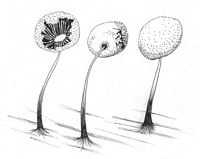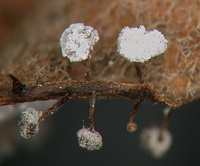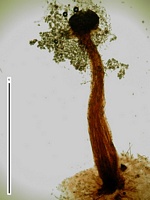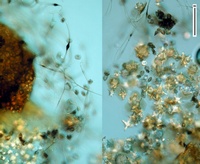|
 Didymium bahiense Didymium bahiense
BiostatusPresent in region - Indigenous. Non endemic
Images (click to enlarge)
Caption: sporangia of Didymium bahiense. Each sporangium is about 1 mm tall.
Owner: S.L. Stephenson | 
Owner: J.A. Cooper | 
Owner: J.A. Cooper | 
Caption: capillitium and stellate crystals from surface.
Owner: J.A. Cooper | |
Article: Stephenson, S.L. (2003). Myxomycetes of New Zealand. Fungi of New Zealand. Ngā Harore o Aotearoa 3: xiv + 238 p. Hong Kong: Fungal Diversity Press.
Description: Fruiting body a stalked sporangium, loosely gregarious, 0.8–1.3 mm total height. Sporotheca subglobose, depressed, scarcely to deeply umbilicate below, white, 0.2–0.7 mm in diameter. Hypothallus small, inconspicuous, venulose or circular, blackish. Stalk slender, subulate, noncalcareous, longitudinally striate, blackish brown below, brown to yellow-brown or yellow above. Columella absent but a columella-like structure (pseudocolumella) present, the latter flat, orbicular, white. Peridium membranous, colourless, covered with white lime crystals, dehiscing in irregular lobes. Capillitium consisting of delicate, light to dark brown, sparsely branched, tightly sinuous, sometimes nodulose filaments with colourless tips, attached to the columella and the peridium. Spores dark brown in mass, violaceous brown by transmitted light, 10–12 µm in diameter, almost smooth to densely and irregularly warted, sometime with clusters of warts. Plasmodium unknown
Habitat: Dead leaves, other types of plant debris, and the dung of herbivorous animals.
Distribution: Described originally from South America and now known from Africa, Asia, Europe, and North America (Ukkola 1998, Yamamoto 1998, Ing 1999, Stephenson et al. 2001). First reported from New Zealand by Mitchell (1992), based on specimens from the Kermadec Islands, Auckland, Coromandel, and Bay of Plenty. Also known from Rangitikei.
Notes: Didymium bahiense is one member of a species complex that also includes two other species (D. iridis and D. nigripes) that have been reported from New Zealand as well as several others not known to occur here. All members of the complex possess a relatively long stalk bearing a more or less globose sporotheca. Clark (2000) has suggested that most of these probably represent little more than slightly different morphological expressions of a single rather variable taxonomic entity, which he has referred to as the Didymium iridis superspecies. However, some forms do appear to be consistently distinguishable on the basis of differences in colour, spore size and markings, and the presence/absence (and shape when present) of a columella or pseudocolumella. The single most distinguishing feature of D. bahiense is the presence of a prominent, white, discoid pseudocolumella that is readily apparent in sporangia that have lost most of their spores.
|